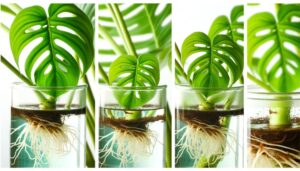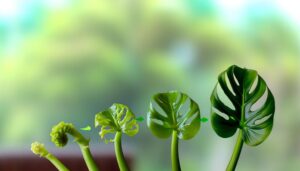Monstera Acacoyaguensis Matuda
Monstera Acacoyaguensis Matuda, hailing from Chiapas, Mexico, flourishes in tropical rainforests with humid, shaded conditions. Its large, fenestrated leaves can reach up to 90 cm long, displaying prominent pinnate venation.
This epiphytic plant uses aerial roots to climb and thrives in rich, organic soil with high humidity. Ensure bright, indirect light and maintain temperatures between 18-27°C.
Fertilize with a diluted 20-20-20 N-P-K blend every four weeks during the growing season. Trim damaged leaves and non-essential aerial roots; propagate using stem cuttings.
Discover more about its fascinating growth habits and essential care techniques.

Key Takeaways
- Native to Chiapas, Mexico, Monstera Acacoyaguensis thrives in humid, shaded tropical rainforests.
- Features large, fenestrated leaves up to 90 cm long with pronounced pinnate venation.
- Prefers bright, indirect light, high humidity (60-80%), and well-drained, rich organic soil.
- Propagate via stem cuttings with nodes and aerial roots, placing in water or well-draining substrate.
- Regularly fertilize with a balanced 20-20-20 N-P-K ratio every 4 weeks during growing seasons.
Origin and Habitat

The Monstera acacoyaguensis Matuda originates from the tropical rainforests of Chiapas, Mexico, where it thrives in humid, shaded environments. You'll find this species nestled in the understory, benefiting from the dappled sunlight filtering through the dense canopy.
The rainforest's rich, organic soil provides essential nutrients, promoting robust growth. In this habitat, Monstera acacoyaguensis Matuda takes advantage of high humidity levels and frequent rainfall, which maintain ideal moisture for its root systems. The consistent temperatures, typically ranging from 20-30°C, create a stable environment conducive to its development.
This species often climbs on tree trunks, using its aerial roots to anchor itself and access better light. Understanding its natural habitat can inform you on how to replicate these conditions in cultivation.
Botanical Features
When examining Monstera Acacoyaguensis Matuda, you'll notice its large, fenestrated leaves, which can reach up to 90 cm in length, exhibiting a cordate base and pinnatifid edges.
The plant's growth habit is scandent, with aerial roots that anchor it to surrounding surfaces, facilitating vertical growth. Its internodes are relatively short, contributing to a compact yet lush appearance.
Leaf Shape and Size
Sporting large, deeply lobed leaves, Monstera acacoyaguensis Matuda exhibits a distinct fenestration pattern that sets it apart from its Monstera relatives. You'll notice that the leaves are ovate to elliptic, with pronounced pinnate venation.
The leaf blades can reach up to 50 cm in length and 30 cm in width, providing a lush, tropical aesthetic. Each leaf displays irregularly spaced fenestrae, or natural holes, which are a hallmark of the genus. This fenestration aids in light penetration and reduces wind resistance, critical for its native habitat.
Additionally, the petioles, or leaf stalks, are robust, supporting the substantial leaf mass. By understanding these botanical features, you'll better appreciate the unique morphology of Monstera acacoyaguensis Matuda.
Growth Habit and Pattern
In its native habitat, Monstera acacoyaguensis Matuda exhibits an epiphytic growth habit, clinging to host trees and climbing upwards to access better light conditions. You'll notice it employs aerial roots (radices aereae) to anchor itself and absorb moisture and nutrients from the air.
This climbing pattern enables the plant to rise above the forest floor, where light is scarce. As it ascends, it produces large, fenestrated leaves, which maximize light capture while minimizing wind resistance. The internodal spacing on the stem (caulis) elongates as it climbs, allowing more efficient energy distribution.
Understanding these growth habits helps you appreciate how Monstera acacoyaguensis adapts to its environment and can inform your cultivation practices in non-native settings.
Ideal Growing Conditions
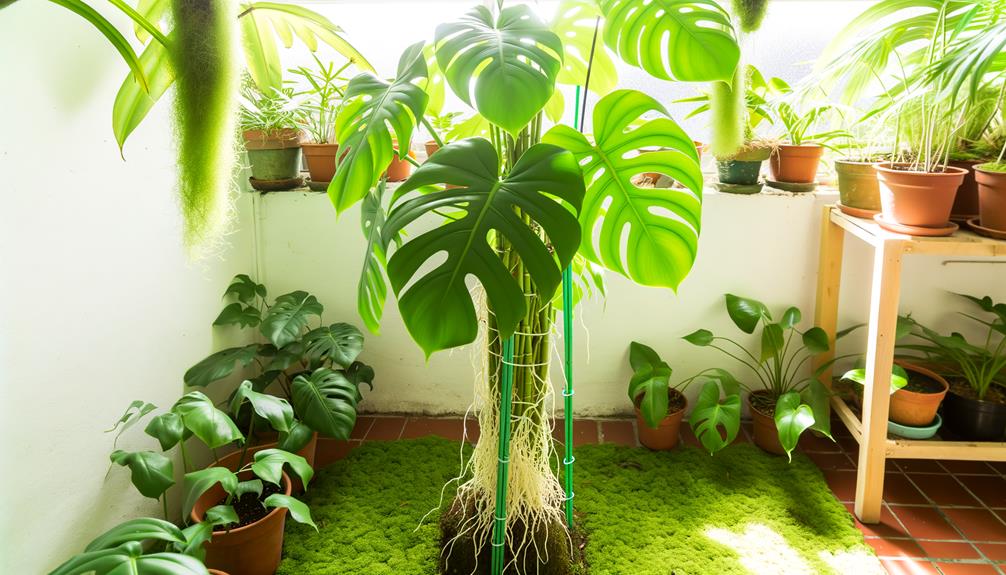
To cultivate Monstera acacoyaguensis Matuda successfully, make certain it receives bright, indirect light to replicate its natural rainforest understory habitat. Maintain ambient humidity levels between 60-80% to mirror its native environment. Temperature should range between 18-27°C (64-81°F), avoiding extreme fluctuations.
Below is a table summarizing the ideal growing conditions:
| Factor | Ideal Range | Notes |
|---|---|---|
| Light | Bright, indirect light | Avoid direct sunlight to prevent leaf scorching |
| Humidity | 60-80% | Use a humidifier if indoor air is too dry |
| Temperature | 18-27°C (64-81°F) | Keep away from drafts and sudden temperature changes |
| Watering | Moderate, well-drained | Allow the topsoil to dry between waterings |
| Air Circulation | Good | Ensure adequate ventilation to prevent fungal growth |
Soil and Potting Mix
Ensuring that Monstera acacoyaguensis Matuda thrives also depends on utilizing a well-aerated, nutrient-rich potting mix that mimics the loose, organic soil of its natural rainforest floor. You should create a blend containing equal parts of peat moss (Sphagnum spp.), perlite (volcanic glass), and orchid bark (fir bark).
This mixture provides excellent drainage and retains adequate moisture, important for root health. Adding compost can enrich the medium with essential nutrients, while charcoal helps filter impurities. Avoid compacted soils, as they hinder root aeration and water flow.
Ensuring a pH level between 5.5 and 7.0 is critical for nutrient absorption. Regularly monitor soil composition to maintain ideal conditions for Monstera acacoyaguensis Matuda.
Watering Needs
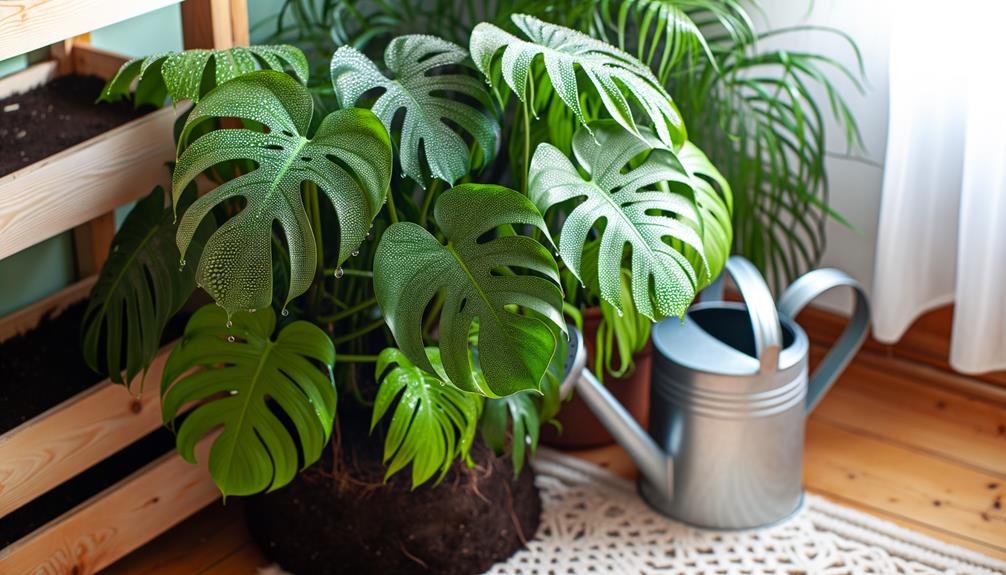
Understanding the exact watering needs of Monstera acacoyaguensis Matuda is essential for maintaining its lush, vibrant foliage and overall health. This species, native to the tropical rainforests, requires consistent moisture without saturation.
Water your Monstera thoroughly until water drains from the bottom, making sure the potting mix (comprising perlite, sphagnum peat moss, and orchid bark) is evenly moist. Allow the top inch of the substrate to dry out between waterings to prevent root rot (Rhizoctonia solani).
During the growing season (spring and summer), you'll need to water more frequently, while in the dormant period (fall and winter), reduce the frequency. Monitor the plant's leaves; wilting indicates underwatering, while yellowing suggests overwatering.
Implementing these practices will ensure ideal hydration.
Light Requirements
Monstera acacoyaguensis Matuda thrives in bright, indirect light, mimicking its native understory habitat.
You'll notice best growth when it receives filtered sunlight, which prevents leaf burn common with direct exposure.
Adjusting light conditions by rotating the plant guarantees even growth and prevents etiolation.
Optimal Sunlight Conditions
To thrive, Monstera acacoyaguensis Matuda requires bright, indirect sunlight, mimicking the dappled light of its native tropical rainforest understory. Place the plant in a location where it receives filtered light, such as near an east-facing window covered with a sheer curtain.
Avoid direct sunlight, as it can scorch the leaves and cause photoinhibition, disrupting photosynthesis. You should aim for approximately 10,000 to 20,000 lux, which replicates the natural habitat's light intensity. If natural light is insufficient, consider using grow lights with a color temperature between 5,000-6,500 Kelvin to simulate natural daylight.
Monitor the plant's leaf color and growth patterns for signs of inadequate light, such as etiolation or chlorosis, and adjust accordingly.
Indirect Light Benefits
In the context of light requirements, indirect sunlight enables Monstera acacoyaguensis Matuda to photosynthesize efficiently without the risk of leaf damage from excessive radiation.
This species thrives under filtered light conditions, mimicking its natural understory habitat. Indirect sunlight provides the ideal illuminance, preventing chlorophyll degradation and maintaining peak photosynthetic rates.
Direct exposure to sunlight can scorch the foliage, causing necrotic spots or chlorosis. By positioning Monstera acacoyaguensis in bright, indirect sunlight, you ensure that its intricate leaves retain their vibrant green hue.
Light diffused through sheer curtains or reflected off walls is ideal. This balance allows the plant to convert light energy into chemical energy effectively, promoting vigorous growth and overall health.
Light Adjustment Tips
Given the importance of maintaining ideal light conditions, you'll need to implement specific strategies to adjust the light exposure for Monstera acacoyaguensis Matuda, guaranteeing it mimics its native understory environment. They thrive in bright, indirect light, avoiding direct sunlight which can scorch their leaves. Positioning them near east or north-facing windows is most suitable. You can use sheer curtains to filter harsh rays. Regularly rotate the plant to promote even growth and adjust artificial lighting if natural light is insufficient.
| Light Condition | Description |
|---|---|
| Bright Indirect | Near east/north window with sheer curtain |
| Partial Shade | Dappled light similar to forest understory |
| Direct Sunlight | Avoid, can cause leaf burn |
| Artificial Lighting | Use grow lights, 12-14 hours daily |
| Rotation Frequency | Rotate every 1-2 weeks for even growth |
Such adjustments guarantee Monstera acacoyaguensis Matuda flourishes.
Fertilizing Schedule

How often should you fertilize your Monstera acacoyaguensis to promote growth and health?
For ideal development, apply a balanced, water-soluble fertilizer with an N-P-K ratio of 20-20-20 every four weeks during the growing season (spring and summer). Make sure the solution is diluted to half-strength to prevent root burn.
In autumn and winter, reduce fertilization to every eight weeks, as the plant's metabolic rate slows. Look for signs of nutrient deficiencies, such as yellowing leaves or stunted growth, to adjust your schedule accordingly.
Always water the Monstera acacoyaguensis before fertilizing to avoid root damage. Remember, over-fertilization can lead to salt build-up in the soil, which impedes nutrient absorption and harms your plant's overall well-being.
Pruning Techniques
To maintain the structural strength and attractive allure of your Monstera acacoyaguensis, you must employ precise pruning techniques tailored to its unique growth patterns. Start by sterilizing your pruning shears to prevent infections. Trim aerial roots (radices aerei) that don't contribute to the plant's support or aesthetics. Remove yellowed or damaged leaves (folia) to redirect energy towards healthier growth. Focus on cutting just above a node (nodus) to encourage new shoots.
Here's a quick reference table:
| Target Area | Action | Outcome |
|---|---|---|
| Aerial Roots | Trim | Enhanced structural support |
| Yellow/Damaged Leaves | Remove | Improved health and appearance |
| Above Node | Prune | Stimulates new growth |
Utilize these techniques to guarantee your Monstera thrives, maintaining its vibrant and engaging appearance.
Common Pests and Diseases
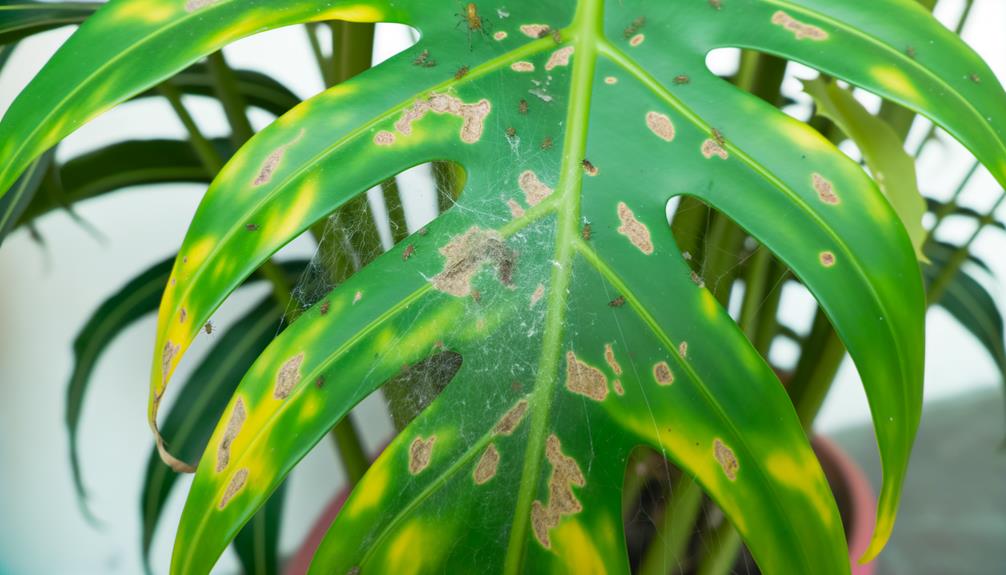
When caring for Monstera acacoyaguensis Matuda, you'll often encounter common pests like aphids (Aphidoidea) and spider mites (Tetranychus urticae) that can damage the foliage.
Watch for fungal diseases such as powdery mildew caused by Erysiphales, which manifest as white, powdery spots on the leaves.
Implementing preventive measures and appropriate treatments will help maintain the plant's health and vigor.
Common Insect Infestations
Monstera acacoyaguensis often faces threats from common insect infestations such as spider mites (Tetranychus urticae), scale insects (Coccoidea), and mealybugs (Pseudococcidae), which can severely impact its health and growth.
Spider mites, tiny arachnids, puncture plant cells and suck out the contents, leading to stippling and leaf discoloration. Scale insects, often found on stems and undersides of leaves, form protective coverings and extract sap, causing yellowing and wilting. Mealybugs, covered in a white, waxy coating, cluster in leaf axils and along veins, secreting honeydew that promotes mold growth.
To manage these pests, regularly inspect your Monstera, employ insecticidal soaps, and consider introducing natural predators like ladybugs or predatory mites.
Fungal Disease Symptoms
Identifying fungal disease symptoms in Monstera acacoyaguensis, such as leaf spot caused by Myrothecium roridum, is essential for early intervention and effective treatment. You'll notice small, water-soaked lesions that eventually turn brown and necrotic. The edges of the spots may be yellow, known as chlorosis.
Here's a handy table to help you identify common fungal symptoms:
| Symptom | Description |
|---|---|
| Leaf Spots | Water-soaked lesions turning brown and necrotic |
| Chlorosis | Yellowing of leaves around infected areas |
| Powdery Mildew | White, powdery fungal growth on leaf surfaces |
| Black Rot | Dark, sunken spots on leaves or stems, causing decay |
These symptoms indicate fungal infections that, if left untreated, can severely damage your Monstera acacoyaguensis.
Prevention and Treatment Methods
To effectively manage and prevent common pests and diseases in Monstera acacoyaguensis, you should implement integrated pest management (IPM) strategies, combining cultural, biological, and chemical controls.
Regularly inspect plants for signs of pests like mealybugs (Pseudococcidae), spider mites (Tetranychidae), and aphids (Aphidoidea).
Use neem oil or insecticidal soap for minor infestations. Introduce beneficial insects like ladybugs (Coccinellidae) to control aphids biologically.
For fungal diseases such as root rot caused by Pythium spp., maintain proper drainage and avoid overwatering. Apply fungicides containing copper or sulfur as a chemical measure.
Maintain ideal humidity levels, and remove infected leaves promptly to prevent disease spread.
Always quarantine new plants to avoid introducing pests or pathogens.
Propagation Methods
Propagation of Monstera acacoyaguensis Matuda can be achieved through stem cuttings, guaranteeing each cutting contains at least one node and a healthy aerial root. First, use sterilized pruning shears to make a clean cut below a node.
Place the cutting in water or a well-draining substrate like peat moss (Sphagnum) mixed with perlite. Maintain high humidity and indirect light to promote root development.
After roots are 2-3 inches long, transfer the cutting to a pot with nutrient-rich, well-aerated soil. Water moderately, allowing the soil to dry between watering sessions.
Ensure the environment remains warm, ideally between 70-85°F. Regularly monitor for pests and diseases to secure the cutting thrives.
Follow these steps, and you'll successfully propagate your Monstera acacoyaguensis Matuda.
Conclusion
In nurturing your Monstera acacoyaguensis Matuda, you'll find a botanical dance of lush foliage and vibrant growth. By mastering its unique needs—from soil and watering to fertilization and pruning—you're not just tending a plant, but creating a living tapestry.
Remember, each leaf unfurls like a green flag of triumph against common pests and diseases. Propagation becomes an art, allowing you to share the beauty of this tropical wonder.
Embrace the journey, and let your Monstera thrive.




